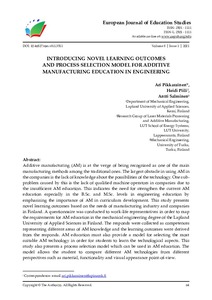Introducing Novel Learning Outcomes and Process Selection Model for Additive Manufacturing Education in Engineering
Pikkarainen Ari; Salminen Antti; Piili Heidi
https://urn.fi/URN:NBN:fi-fe2021042821716
Tiivistelmä
Additive manufacturing (AM) is at the verge of being recognised as one of the main manufacturing methods among the traditional ones. The largest obstacle in using AM in the companies is the lack of knowledge about the possibilities of the technology. One sub-problem caused by this is the lack of qualified machine operators in companies due to the insufficient AM education. This indicates the need for strengthen the current AM education especially in the B.Sc. and M.Sc. levels in engineering education by emphasising the importance of AM in curriculum development. This study presents novel learning outcomes based on the needs of manufacturing industry and companies in Finland. A questionnaire was conducted to work-life representatives in order to map the requirements for AM education in the mechanical engineering degree of the Lapland University of Applied Sciences in Finland. The responds were collected as competences representing different areas of AM knowledge and the learning outcomes were derived from the responds. AM education must also provide a model for selecting the most suitable AM technology in order for students to learn the technological aspects. This study also presents a process selection model which can be used in AM education. The model allows the student to compare different AM technologies from different perspectives such as material, functionality and visual appearance point-of-view.
Kokoelmat
- Rinnakkaistallenteet [19207]
